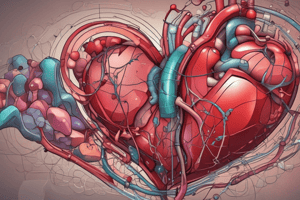Podcast
Questions and Answers
What is the primary mechanism of action of Class 1A antiarrhythmic drugs?
What is the primary mechanism of action of Class 1A antiarrhythmic drugs?
- Blockage of fast Na+ channels in the open or activated state (correct)
- Blockage of slow Na+ channels in the inactivated state
- Blockage of K+ channels
- Blockage of Ca2+ channels
Which of the following is a unique property of Quinidine?
Which of the following is a unique property of Quinidine?
- Is metabolized by N-acetyltransferase
- Causes vasoconstriction
- Prolongs repolarization
- Blocks muscarinic receptors (correct)
What is a potential adverse effect of Quinidine?
What is a potential adverse effect of Quinidine?
- Hypertension
- Tachycardia
- Hypotension (correct)
- Bradyarrhythmia
What is a characteristic of Procainamide metabolism?
What is a characteristic of Procainamide metabolism?
What is a potential adverse effect of Procainamide?
What is a potential adverse effect of Procainamide?
What is the mechanism of action of Class 1B antiarrhythmic drugs?
What is the mechanism of action of Class 1B antiarrhythmic drugs?
What is the effect of Class 1B antiarrhythmic drugs on action potential duration (APD)?
What is the effect of Class 1B antiarrhythmic drugs on action potential duration (APD)?
What is the effect of Class 1B antiarrhythmic drugs on diastole?
What is the effect of Class 1B antiarrhythmic drugs on diastole?
What is the primary use of lidocaine in cardiac arrhythmias?
What is the primary use of lidocaine in cardiac arrhythmias?
Which Class of anti-arrhythmic drugs includes beta blockers?
Which Class of anti-arrhythmic drugs includes beta blockers?
What is the effect of Class III anti-arrhythmic drugs on the action potential?
What is the effect of Class III anti-arrhythmic drugs on the action potential?
Which of the following is a side effect of amiodarone?
Which of the following is a side effect of amiodarone?
What is the primary mechanism of action of verapamil?
What is the primary mechanism of action of verapamil?
What is the treatment for Torsade de pointes?
What is the treatment for Torsade de pointes?
Which of the following is a characteristic of Class I anti-arrhythmic drugs?
Which of the following is a characteristic of Class I anti-arrhythmic drugs?
What is the effect of flecainide on the action potential?
What is the effect of flecainide on the action potential?
Flashcards are hidden until you start studying
Study Notes
Class I: Na+ Channel Blockers
Class 1A: Antiarrhythmic
- Block fast Na+ channels (↓ INa) in open or activated state
- Also block K+ channel, prolonging repolarization and action potential duration
- Effective refractory period is increased
- Drugs:
- Quinidine • Causes muscarinic receptor blockade, increasing HR and AV conduction • May cause vasodilation via alpha block with possible reflex tachycardia • Orally effective, with wide clinical use in many arrhythmias • Adverse effects: cinchonism, hypotension, prolongation of QRS and QT interval, and torsade
- Procainamide • Less muscarinic receptor block • Metabolized to N-acetyl procainamide (NAPA), an active metabolite • Adverse effects: systemic lupus erythematosus (SLE)-like syndrome, hematotoxicity, and CV effects (torsade)
Class 1B
- Block fast Na+ channels (↓ INa) in inactivated channels
- Preference for tissues partly depolarized (slow conduction in hypoxic and ischemic tissues)
- Increased threshold for excitation and less excitability of hypoxic heart muscle
- Decreased APD due to block of slow Na+ “window” currents
- Increased diastole and extended time for recovery
- Drugs and uses:
- Lidocaine • Used in post-MI, open-heart surgery, and digoxin toxicity for ventricular arrhythmias only • Side effects: CNS toxicity, seizures • IV use due to first-pass metabolism
- Mexiletine • Same uses as lidocaine • Oral formulations
Class 1C
- Block fast Na+ channels (↓ INa) in His-Purkinje tissue
- No effect on APD
- No ANS effects
- Drug:
- Flecainide • Limited use due to proarrhythmogenic effects, leading to increased sudden death post-MI and in VT
Class II: Beta Blockers
- Prevent β-receptor activation, which normally increases cAMP
- Decrease SA and AV nodal activity
- Decrease slope of phase 4 of AP in pacemakers
- Drugs:
- Propranolol (nonselective) and cardioselective drugs (acebutolol and esmolol)
- Uses: • Prophylaxis post-MI and in supraventricular tachyarrhythmias (SVTs) • Esmolol (IV) used in acute SVTs
Class III: K+ Channel Blockers
- Decrease IK (delayed rectifier current), slowing phase 3 (repolarization) of AP
- Increase APD and ERP, especially in Purkinje and ventricular fibers
- Drugs:
- Amiodarone • Mimics classes I, II, III, and IV • Increases APD and ERP in all cardiac tissues • Uses: any arrhythmias • t1/2 >80 days • Binds extensively to tissues (large Vd and multiple effects) • Side effects: pulmonary fibrosis, blue pigmentation of the skin, phototoxicity, corneal deposits, hepatic necrosis, and thyroid dysfunction
- Sotalol • Decreases IK, slowing phase III • Nonselective beta blocker: β1 blockade, leading to decreased HR, decreased AV conduction • Uses: life-threatening ventricular arrhythmia • Side effects: torsade
Class IV: Ca2+ Channel Blockers
- Block slow cardiac Ca2+ channels
- Decrease phase 0, decrease phase 4
- Decrease SA, decrease AV nodal activity
- Drugs:
- Verapamil and diltiazem • Prototype Ca2+-channel blockers • Uses: supraventricular tachycardias • Side effects: constipation, dizziness, flushing, hypotension, AV block • Drug interaction: additive AV block with β-blockers, digoxin; verapamil displaces digoxin from tissue-binding sites
Treatment of Torsade
- Correct hypokalemia
- Correct hypomagnesemia
Studying That Suits You
Use AI to generate personalized quizzes and flashcards to suit your learning preferences.




